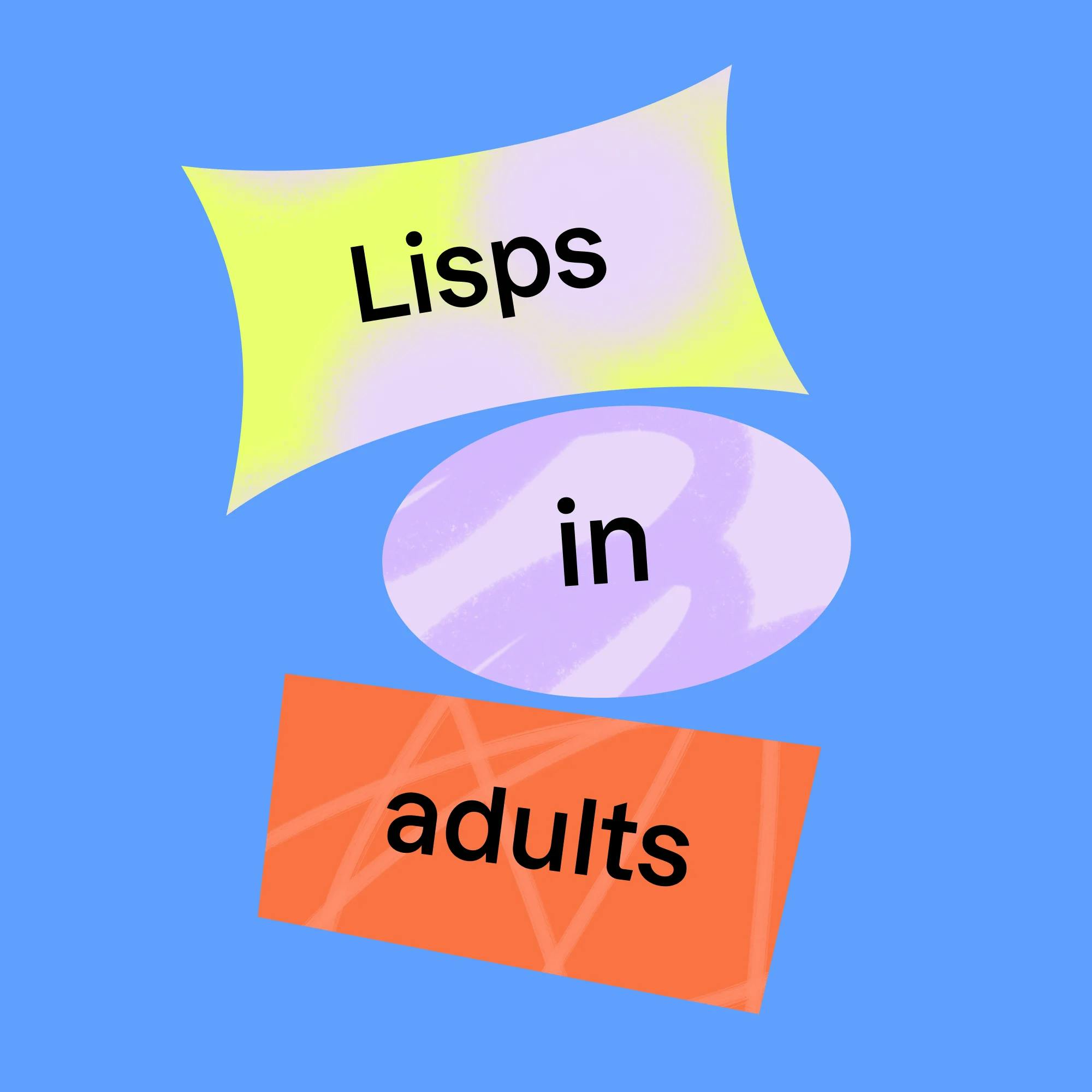A lisp is a speech difference that affects how a person pronounces the /s/ and /z/ sounds. The most common lisp is the interdental lisp, where the tongue sticks out between the front teeth. Lisps can continue into adulthood, but most people can fix a lisp with speech therapy that teaches correct tongue placement and airflow. Learn what causes a lisp, how to fix it, and when to see a speech therapist.
Lisps are one of the most common speech issues in both children and adults. Many people who have a lisp wonder if it’s possible to fix it. Here’s the good news: in most cases, yes, it is.
As speech-language pathologists, we often hear from families who are confused about why a lisp happens or unsure how to fix a lisp at home. A lisp usually comes from learned tongue placement patterns that can be changed with the right practice and guidance.
In this article, you’ll learn the four types of lisps, what causes a lisp, and step-by-step tips for getting rid of a lisp. By the end, you’ll understand what a lisp sounds like, when to seek help, and how speech therapy can support clearer, more confident communication.
Find the right speech therapist for you
We'll match you with a speech therapist who's experienced in your area of need and available when you are.
 Get started
Get startedWhat is a lisp?
A lisp refers to difficulty pronouncing the /s/ or /z/ sounds. This is because of an incorrect motor pattern of tongue positioning.
When a person has a lisp, they position their tongue in a way that blocks or distorts the airflow needed to make the /s/ and /z/ sounds. This distortion of airflow creates the lisping sound we are familiar with.
What is the most common lisp?
An interdental lisp, sometimes called a frontal lisp, is the most common lisp. This is where a [th] sound is produced instead of an /s/ or /z/ sound. If you or your child has an interdental lisp, a word like “sing” may be pronounced as “thing,” and a word like “zebra” may be pronounced as “thebra.”
“It's called an interdental lisp because the tongue is placed incorrectly in the speaker’s mouth, often protruding between the front teeth,” says Abby Barnes, M.S., CCC-SLP, a speech-language pathologist at Expressable.

Other types of lisps
Dentalized lisp
A dentalized lisp is similar to the interdental lisp. While the tongue doesn’t completely protrude between the front teeth, it does push against the back of the front teeth, directing airflow forward. This can cause a muffled sound when speaking.

Lateral lisp
A lateral lisp makes a very distinguishable sound once you know what to listen for. In this type of lisp, the tongue stays in a relatively correct position. However, the sides of the tongue are raised enough to cause air to escape from either side of the mouth. All of this extra air causes the speaker to sound “slushy,” and speech takes on a uniquely “wet” or “spitty” characteristic. In fact, you may even hear a lateral lisp called the “slushy lisp.”

Palatal lisp
A palatal lisp occurs when the tongue raises up and touches the roof of the mouth, also called the soft palate. While this type of lisp is not as common, it can make it hard to pronounce the /s/ and /z/ sounds.

What causes a lisp?
The reason for the incorrect tongue positioning that causes a lisp isn’t always clear. Lisping can be caused by a variety of factors, including:
Learning to produce the /s/ and /z/ sounds incorrectly as a child
A jaw misalignment, or problems with a person’s jaw alignment
A tongue tie, which occurs when the tongue is attached to the bottom of the mouth and its movement is limited; this may lead to a lateral lisp
A tongue thrust, in which the tongue protrudes forward; this can also impact feeding and swallowing


Is it possible to get rid of a lisp?
Yes, you can get rid of a lisp at any age with the help of speech therapy. A speech-language pathologist, also known as a speech therapist, can identify what kind of lisp you have, then teach you how to change your tongue placement and control your airflow so you can produce sounds more clearly.
“Therapy often includes targeted exercises, step-by-step practice, and lots of repetition to help build new speech habits,” says Barnes. With consistent practice, most people make great improvements, often faster than they expect. It’s never too late to strengthen your speech skills and boost your confidence.
Claudia's story
With online speech therapy, Claudia got rid of a lisp she'd had since childhood--and learned to communicate with more confidence.
 Read Claudia's story
Read Claudia's storyHow to fix a lisp
If you’re ready to work on correcting a lisp, the tips and exercises below can help you get started at home. However, keep in mind that working with a speech therapist is the best way to get rid of a lisp. In speech therapy, you will learn to say the /s/ sound correctly at various levels, in a specific order, so you can achieve success. Practicing a sound incorrectly, at a higher level than you’re ready for, can cause you to form an incorrect motor pattern. You would then need to “unlearn” that motor pattern in order to say the sound correctly.
To avoid worsening the lisp or causing new problems, having a speech therapist guiding this process is your best bet!
Tips for correcting an interdental lisp
Since interdental lisps are caused by incorrect tongue placement, they’re easy to visualize. This can be helpful when trying to correct this type of lisp. For example, when looking in a mirror, it’s often easy to see the tongue protruding between the two front teeth. If you or your child is trying to fix an interdental lisp, use this to your advantage and practice in front of a mirror!
The tongue should go behind the front teeth. It should barely touch the “bumpy part” of the mouth right behind your teeth, called the alveolar ridge. When the tongue is in the correct position and you begin to push air gently out, the air should flow smoothly right over the tongue and out the front of your mouth.
For quick practice, work with your child in front of the mirror. Watch closely how their teeth and mouth move when saying the /s/ or /z/ sound.
If your child has an interdental lisp, show them the correct tongue placement yourself. See if they can imitate your mouth movements. This can be helpful for anyone, especially those of us who are more visual learners.
Tips for correcting a lateral lisp
If you think that you or your child has a lateral lisp, you can once again try practicing the exploding /t/ technique. This will help position the tongue correctly so that airflow is directed out of the front of the mouth.
You can also use a straw and hold it in front of the teeth. Try to make the air come through the straw instead of out the sides of the tongue. You’ll quickly notice the difference, as the sound varies considerably depending on where the airflow is directed. This activity also provides quick feedback so that the speaker can continue working on their /s/ or /z/ productions.
Tips for correcting a dentalized lisp
To help fix a dentalized lisp, focus on making the tongue only lightly touch behind the front teeth, instead of pushing hard against them.
One simple exercise for a dentalized lisp is called the exploding /t/ technique. To begin, say the /t/ sound four times in a row, and then hold the sound on the last one. It will go something like: t-t-t-tsssssss. The /t/ will automatically turn into an /s/ sound. Pretty cool, huh? Try another with just one exploding /t/: t-ssss.
Then, try to produce the /s/ sound while maintaining that same placement. It will sound correct because the tongue is now in the correct position.
Tips for correcting a palatal lisp
In order to fix this type of lisp, it's important to review appropriate tongue placement.
You may also need to focus on lowering the tongue slightly so that the body of the tongue is not raised as high when speaking.
It's common for a person with a palatal lisp to keep their mouth slightly open when making the /s/ or /z/ sound. If so, have them watch their tongue placement in the mirror. Model correct tongue placement, so that the tip of the tongue only touches slightly behind the teeth, and the body of the tongue is positioned lower in the mouth instead of touching the palate.
When should a lisp be corrected?
There are a few things to think about before deciding if it’s time to correct an /s/ or /z/ sound.
1 How old is the person with the lisp?
When children first begin talking, often around the age of 2, lisps can start to become noticeable. Kids can learn to make the /s/ sound clearly anytime between ages 3 and 8. However, it’s a good idea to start working on this sound before age 8. If a child is able to make an /s/ sound that's close to correct, it's a safe bet that they're ready to begin practicing this sound in speech therapy.
Remember that a lisp can be corrected in adults, too. It’s never too late!
2 What type of lisp does the person have?
Dentalized and interdental lisps are relatively common and normal in young children. Many children have this kind of lisp up to around 4½ years of age. Lateral and palatal lisps, however, do not occur as a normal part of speech development.
Either way, it’s a good idea to talk with a speech therapist, who can evaluate and identify the type of lisp that you or your child may have. They can provide a clinical recommendation on how best to correct the lisp.
3 Is the lisp affecting the person’s confidence or self-esteem?
“Lisping affects everyone differently, and not everyone wants to change the way they speak,” Barnes says. However, speech sound differences that affect how clearly a person speaks may impact their confidence, self-esteem, and willingness to participate and socialize with others.
When to see a speech therapist for a lisp
If you think that you or your child have a lisp, or you notice your child struggling with their /s/ and /z/ sounds with little improvement over time, contact a speech therapist. Their professional guidance will help you make the most informed treatment decision.
At Expressable, we’re here to listen to your speech concerns and guide you on next steps. We can match you with a licensed speech therapist who can perform an evaluation and develop a treatment plan. Get in touch with us here!
Frequently asked questions (FAQs)
What’s a lisp?
A lisp is a type of speech difference where the /s/ or /z/ sounds are produced with incorrect tongue placement, causing the airflow to distort. This can make the sound come out as “slushy,” “spitty,” or like a [th] sound. If you’re not sure whether you or your child have a lisp, you can take our free online screener to get personalized guidance.
What is the most common lisp?
The most common lisp is the interdental lisp. The tongue sticks out between the front teeth, making a [th] sound instead of /s/ or /z/. For example, “sun” may sound like “thun.” A speech-language pathologist can evaluate the type of lisp you may have and recommend treatment options.
Is a lisp only with the /s/ sound?
A lisp typically affects the /s/ and /z/ sounds, since these sounds rely on precise airflow and tongue placement. However, if the tongue positioning pattern is more severe, it can sometimes affect other sounds as well. A speech therapist can help determine the full impact.
Is a lisp a form of autism?
No. A lisp is not a form of autism. A lisp is a speech production issue related to tongue placement and airflow. Autism is a neurological developmental condition. While autistic people may also have speech differences, a lisp on its own is not a sign of autism.
What causes a lisp in adults?
Adults may have a lisp for several reasons, including incorrect tongue placement learned in childhood, a history of tongue thrust, a tongue tie, or jaw alignment differences. Some adults simply never received treatment as children. If a lisp is affecting your clarity or confidence, consider contacting a speech therapist for an evaluation to explore your options.
Is it possible to get rid of a lisp?
Yes. Most lisps (at any age) can improve significantly with speech therapy. Treatment focuses on retraining tongue placement and directing airflow correctly so the /s/ and /z/ sounds become clearer. Many people see progress faster than they expect.
Is it possible to self-correct a lisp?
Some mild interdental lisps can improve with focused practice and visual feedback, like watching tongue placement in a mirror or trying the “exploding /t/” technique. However, many people need speech therapy in order to change long-standing speech habits. Click here to get matched with a speech therapist.
Does insurance cover speech therapy for adults with a lisp?
Some insurance plans do not consider speech therapy for a lisp to be medically necessary for adults. As a result, they may not cover it. Each insurance plan has their own qualifications for what they deem medically necessary, so it's important to understand your plan's coverage if you'd like to use it for speech therapy.
Key takeaways
A lisp is a speech difference caused by incorrect tongue placement during /s/ and /z/ sounds, leading to distorted airflow and unclear speech.
The most common lisp is the interdental lisp, where the tongue sticks out between the front teeth and sounds like a [th].
Lisps can be caused by learned patterns, tongue thrust, tongue tie, or jaw alignment.
Children and adults can correct a lisp through speech therapy that teaches proper tongue placement, airflow control, and new speech habits.
If a lisp affects speech clarity, confidence, or social participation, contact a speech therapist for an evaluation and a personalized treatment plan.
How Expressable Can Help
Concerned your child isn't reaching age-expected milestones? Looking for communication support from a professional? Expressable is a national online speech therapy practice serving children and adults. We treat all major areas of communication and feeding, offer flexible hours including evenings and weekends, and accept most major health insurance plans. We’re proud to have earned more than 3,000 5-star reviews from our clients (4.9/5 average).
Our therapy model is centered on parent and caregiver involvement. Research proves that empowering caregivers to participate in their loved one’s therapy leads to better outcomes. That’s why we combine live, 1-on-1 speech therapy with personalized education and home practice activities for faster progress.
Communication is more than words. It’s how we share how we feel and show who we are. We’re here to help you or your child do just that.

 Leanne Sherred, M.S., CCC-SLP
Leanne Sherred, M.S., CCC-SLP










